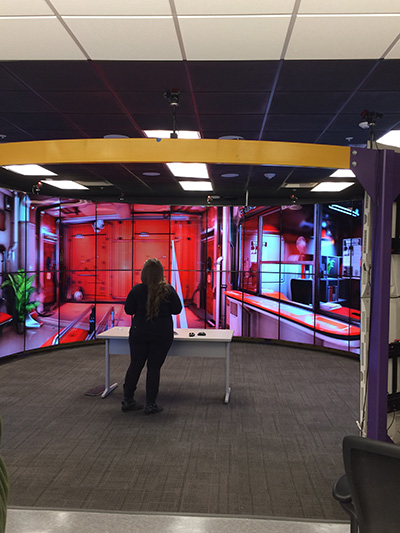Virtual Reality Becomes Reality for Engineering Students
03-05-18
BATON ROUGE - Imagine designing a bridge and being able to stand on it before it’s built, or walking through a new building before the first slab has been poured. This is what LSU Engineering students are able to do now in the new MMR Building Information Modeling (BIM) Lab in Patrick F. Taylor Hall.
“The Cave,” as it is so often referred to, is a virtual reality environment that has become a reality for College of Engineering faculty and students.
When Professor Yimin Zhu joined LSU’s Bert S. Turner Department of Construction Management in 2014, he and Professor Robert Kooima of the School of Electrical Engineering and Computer Science voiced their desire for a BIM Cave (Cave Automatic Virtual Environment). At the time, students were using 3-D computer-aided design (CAD) data that was limited by 2-D monitors and paper printouts.
The MMR BIM Cave, on the other hand, would allow Zhu and other professors to actually show their students what their projects looked like through virtual reality. The technology was there; the college just needed the funding.
With support from the University Technology Fee program, matching funds from the Construction Industry Advisory Council, and gifted infrastructure from MMR, the College of Engineering was able to build the BIM Lab and Cave in the newly renovated PFT in the summer of 2017.
“MMR helped a lot,” Zhu said. “Without their help, I just don’t know how we could have done it.”
The MMR BIM Lab is a 2,400-square-foot room that houses the Cave, which consists of 44 55-inch OLED display screens that provide a 300-degree visual, creating a VR environment. There are 11 PCs connected to one large PC that runs the Cave. Sensors are in place to track movement, temperature and humidity.
“The Cave provides a certain amount of immersion but the viewpoints are very different,” Zhu said. “It gives you a sense of being in a certain environment. There are two purposes for the Cave. One is data visualization. The Cave is a visualization platform that provides us with stereoscopic views for many participants at the same time.
“The second purpose is for teaching. We do have other means to visualize 3-D or virtual models but many of them are either on the desktop or use the head mount, which is more immersed but individual. For teaching in a group, the Cave is fabulous.”
Weile Wei, a PhD CM student who is working on a project with Zhu, shares his professor’s sentiment.
“When you have participants in the same room at the same time, they share the same visualization,” Wei said. “They are able to discuss back and forth, provide suggestions or comments, and modify it.”
Wei’s current project is called “BIM Cave Support Safety Training” and focuses on how to use VR technology to create a safe working environment for construction workers.
“A construction site has lots of hazards,” he said. “People can fall down or get hit by objects, even trucks. The Cave lets us put workers into that [construction] environment without hazard exposure. It also saves on cost.”
PhD CM students Maryam Mollazadeh, Asal Emamjomeh and Pedram Ghannad are also working on a project in the Cave that deals with lighting.
“Our project evaluates different types of lighting in commercial buildings, giving owners and customers feedback from the Cave,” Ghannad said. “Making a decision about a lighting system depends on the feedback or feeling of the people when it’s a commercial building. The Cave gives the feeling of presence to people in the real environment.”
As for how the 3-D images are transferred to the Cave, Mollazadeh says, “First you create a 3-D model using Rivet; then you export the model to a particular software, in this case, Unreal Engine. Then students are asked to test the VR environment in the Cave.”
“For a learned person, it’s very fast,” Zhu said. “Deployment doesn’t take much time. It’s the modeling that takes time.”
On working with Zhu, all four students vouch for his knowledge of the MMR BIM Lab.
“He can answer your questions about the BIM,” Ghannad said. “There are not many people who know about the BIM, so it’s important to have a professor who knows a lot about it.”
“Dr. Zhu is a very knowledgeable person,” Wei said. “He knows basically everything about construction management, human behavior and high-end technology because the Cave is one of the most cutting-edge technologies in the world. We see the future in the Cave.”
Zhu says that other fields besides construction management are excited to use the MMR BIM Cave and he couldn’t be more thrilled about the prospect.
“We want to have more classes use it,” he said. “And by working with computer science and computer engineering, we can develop the Cave.”
The MMR BIM Cave and Lab is located in room 2348 on the second floor of PFT.
By Libby Haydel
Communications Specialist
ehaydel1@lsu.edu
225-578-4840